Wild, Domesticated, Bred, and Engineered –
Where Did We Begin and Where Might We Go?
By Matt Dillon, Director of Advocacy, Organic Seed Alliance
Photo: Matthew Dillon.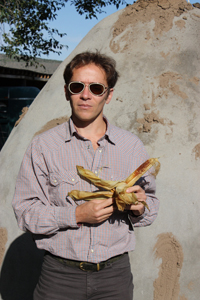
How did a wild, inedible, coastal plant from the Mediterranean Coast develop over thousands of years to exist as both an organic chard and as a biotech sugar beet?
In addition to being an aspect of the intergenerational life cycle of sexually producing plants and a vehicle for inheritance of thousands of previous generations of life, seed is also a narrative describing the history of plant and human relationships. In form and in essence seed shares much with story; it is information encapsulated, information that can evolve with each telling or that can stagnate and disappear. Over the last 12,000 years we have selected seeds for domestication, a taming of the wild, much in the same way that we have created mythologies to give some meaning to life and death and to civilize the chaos of the cosmos. The risk is that as we move the wild out of seed, we may lose something of its essence. Seed is potential to move into new environments, reinvent forms, and escape limitations. The loss of this potential is one of the great risks of our times. Our dominant modern seed systems want to reduce seed to no more than binary coding – a "delivery mechanism" that can be programmed to become an input that delivers very specific outputs. How did we arrive at this view, and what are the other stories being told as we attempt to envision the inheritance of generations to come?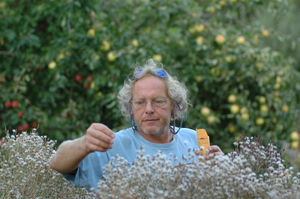
Photo: Frank Morton provides this caption for his photo, “Here I am collecting seed of lettuce, with which I share a certain resemblance, and in the background hang apples, which somehow seem iconic to the Garden.” Photo by Karen Morton.
Matthew Dillon of Organic Seed Alliance and Frank Morton of Wild Garden Seeds will tell a story which spans the history of seed: from crop domestication by hunter-gatherers to the scientific revolution; from pre-modern breeding prior to the study of genetics, including the rediscovery of Mendelian genetics and the first wave of classical breeding, the biotech boom, and the agro-ecological approach to seeds. Join us for a free public lecture from 5:30 to 7 p.m. on Friday, April 16, at the Outrigger Keauhou Beach Resort.
The Hua Ka Hua—Restore Our Seed Symposium will follow on April 17 and 18, also at the resort. To learn more about the symposium or to pre-register, visit http://kohalacenter.org/seedsymposium/about.html.

A Bright Idea
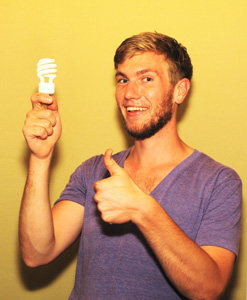
Photo: The Kohala Center has enlisted the help of two enthusiastic volunteers, Ezekiel Fugate (shown here with a CFL light bulb) and Aaron Tanimoto, who will be visiting with participating community groups to share why switching to CFL bulbs makes such good sense for Hawai‘i Island families.
On April 1, The Kohala Center is launching a light bulb exchange program on Hawai‘i Island. School and community groups are encouraged to join in this effort to replace old-style incandescent light bulbs with more energy efficient Compact Fluorescent Light (CFL) bulbs—free of charge!
To participate, groups must commit to replacing at least 500 incandescent bulbs with CFL bulbs. In return for your efforts to make our community more energy efficient, Blue Planet Foundation will award $1 for every old-style bulb replaced, up to a maximum of $500 per group. “What a great way to support the environment, reduce carbon emissions, and educate the community about energy efficiency and climate change,” says TKC Project Coordinator Guy Kaulukukui. “CFL bulbs need less electricity to produce the same amount of light. Replacing five hundred 60-Watt bulbs with our 13-Watt CFLs will keep over 375 barrels of oil from being burned to make electricity. And that means avoiding the air pollution from tons of carbon dioxide,” explains Kaulukukui.
The CFL Light Bulb Exchange Fundraiser Project is a partnership between Blue Planet Foundation and The Kohala Center. Blue Planet Foundation’s mission is to “end the use of fossil fuels in Hawai‘i and replace them with clean, renewable, and indigenous sources of energy.” The Kohala Center is the point of contact for the bulb exchange on Hawai‘i Island and will be providing direct support to participating groups. For more information on the logistics of the bulb exchange, visit www.kohalacenter.org/bulbexchange2010.html. To sign up your group for the program, e-mail bulbexchange@kohalacenter.org or call Guy Kaulukukui at (808) 887-6411. Groups will be accepted on a first-come, first-served basis until our island allotment of 5,000 CFL bulbs is exhausted.

Exploratory Research
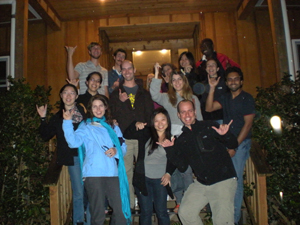
Photo: Yale team members enjoyed dinner at the home of Kohala Center Deputy Director Betsy Cole. (Front row) Melissa Ivins, BinBin Jiang, Gabriel Mejias; (Second row) Tian Wang, Amanda Chavez-Kupp, Andrew Bostrom, Stefania Panousi, Mariana Sarmiento, Srinath Sabapathy; (Back row) Ezekiel Fugate, Christopher Cooke, Betsy Cole, Professor Marian Chertow, Mona Yang, Troy Savage. Photo by Lauren Barredo.
Students in the Industrial Ecology Program at Yale University were on Hawai‘i Island in March to officially launch four research projects here, funded by a National Science Foundation (NSF) grant. The students, led by Principal Investigator Marian Chertow, are engaged in an effort to quantify differences between Hawai‘i Island’s two major urban centers: Hilo and Kailua-Kona. The NSF awarded a series of exploratory grants in 2009 to study how both human and environmental factors interact over time at selected urban sites across the country. Hawai‘i Island is one such exploratory site, and NSF funding is supporting research projects on the island to look at energy use, water and wastewater systems, imports and exports, and possible ways to recover existing “waste” streams on the island for agricultural use.
The ultimate goal of this project is to identify challenges and opportunities in the existing systems in order to maximize use of available resources and create more sustainable solutions in the long-term. The Kohala Center is a partner in this NSF research, called the ULTRA-EX Project, which is the first stage of the Long-Term Industrial Ecosystem Model-Hawai‘i Program.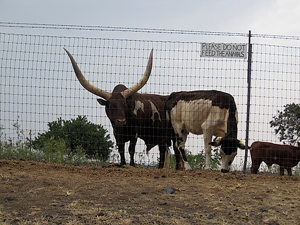
Photo: Longhorn cattle near Captain Cook in South Kona. Photo by Lauren Barredo.
The recent visit by Yale graduate students was insightful and productive. The students spent their time collecting information on material, energy, and water flows from a variety of government agencies, companies, and other entities. In their interviews, the students were struck by several recurring themes which were identified and expressed by a diverse group of island residents. These themes, which included energy independence, import dependence, the fragility of the tourist economy, food self-reliance, and waste assimilation, all stem from a systemic understanding of resource management. Because industrial ecology is founded around such an understanding, the students’ projects will provide a useful foothold for members of the island community as we work to design our systems (e.g., imports, waste, energy, and food) to flourish within the bounds of the natural world. —Ezekiel Fugate, Yale/Kohala Center Research Associate
Read more about The ULTRA-EX Project on the Back Page.

Hawai‘i Island Coastal Education and Stewardship Project
Photo: UHH Education students demonstrating the extent that our oceans cover the surface of the Earth and the significance of ocean stewardship to students in Hilo.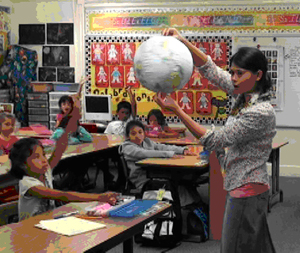
The HICES project is based on the premise that it is never too early to learn about and to start caring for the ocean and all the animals that live there. Getting our up and coming teachers working directly with young elementary students on coastal education and stewardship through the HICES project has been an exciting learning voyage for everyone involved. I hope all the HICES participants will keep the lessons gleaned from this adventure in their hearts as they enter the teaching profession. —Darius Kalvaitis, Assistant Professor in the UH Hilo Education Department
Elementary students at Connections Public Charter School and Keaukaha Elementary School, UHH Education pre-service teachers, and local ocean related organizations have joined together through the Hawai‘i Island Coastal Education and Stewardship (HICES, pronounced “High Seas”) project to mālama ke kai (care for the ocean). The HICES project is a collaborative endeavor led by Dr. Darius Kalvaitis, an assistant professor in the UHH Education Department, and facilitated by Hoʻoululāhui Erika Perry, an experienced environmental educator.
Photo: The HICES project strives to make learning meaningful and fun. Students love observing the fish up close at Mokupapapa Discovery Center.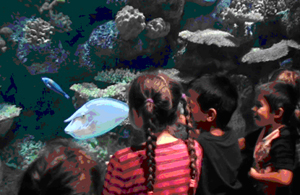
The HICES project is helping to train pre-service teachers, educate K–6 students, and engage the broader community in ocean education and stewardship. At the same time, the project is building stronger working relationships between environmental education organizations on the island. Some of the many organizations that have joined forces in an effort to promote conservation of our coastal resources include the UHH Pacific Aquaculture & Coastal Resources Center, NOAA’s Mokupapapa Discovery Center, Hilo Bay Watershed Advisory Group, Na Pua No‘eau Center for Gifted and Talented Native Hawaiian Children, and The Kohala Center. The HICES project was funded by a grant from the Environmental Protection Agency.
“This project fosters environmental education at multiple levels by empowering its partners and participants to work together,” says Kalvaitis. “Using coastal conservation as an integrating context for learning, the HICES project promotes a lifetime stewardship ethic for all involved.”
Read "A Lifetime Stewardship Ethic" on the Back Page.

A Generation of New Leaders
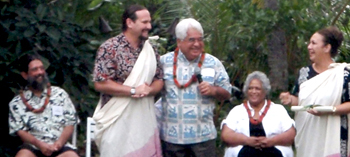
Photo: Fellows Kamana Beamer (second from left) and Nālani Sing (far right) seen here with Mellon-Hawai‘i Fellowship Selection Committee members Dr. James Kauahikaua (far left), Robert Lindsey (center), and Dr. Pualani Kanahele (second from right).
Dr. Kamanamaikalani (Kamana) Beamer, 2008 Mellon-Hawai‘i Postdoctoral Fellow, was recently appointed as Land Legacy Education Manager in the Land Assets Division (LAD) of the Endowment Group of Kamehameha Schools, Hawai‘i’s largest Native trust. As Land Legacy Education Manager, Beamer provides leadership for the division which manages Hawai‘i agricultural and conservation lands in an effort to achieve a balance of cultural, economic, educational, environmental, and community benefits. The division’s placed-based educational initiatives include the First Nations Futures Program, a fellowship operated in partnership with Stanford University, Maori tribal organizations and the University of Hawai‘i involving Hawaiian and Maori post-graduate, early- and mid-career individuals.
Dr. Beamer is committed to his scholarship, to his community, and to the lands of Hawai‘i. It is wonderful to see him assume such an important leadership position, in which the lands of Hawai‘i are respectfully engaged as a source of environmental and cultural knowledge for Hawai‘i’s communities. —Matt Hamabata, Executive Director of The Kohala Center
Learn more about Kamana on the Back Page.

Ahupua‘a Restoration
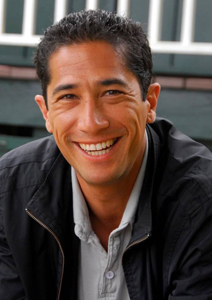
Photo: Kāwika Winter.
Kāwika Winter, Director of Limahuli Garden and Preserve on Kaua‘i will present two free lectures as part of the Puana Ka ‘Ike (Imparting Knowledge) lecture series. Winter will speak on “Ahupua‘a Restoration: Melding Science and Culture to Produce Models of Sustainability” from 5:30 to 7 p.m. on Friday, April 30 at the Keauhou Beach Resort Ballroom in Kona, and from noon to 1:30 p.m. on Monday, May 3, at the University of Hawai‘i at Hilo, UCB 127.
“With upwards of 95% of our food and energy being shipped into Hawai‘i, the most remote land mass on the planet, there is room for improvement when it comes to issues of sustainability,” explains Winter. “The ahupua‘a (loosely translated as watershed) system of resource management existed here in these islands for at least a millennium. This management system harnessed ecosystem services to provide for a large and healthy population, while at the same time maintaining ecosystem integrity and high levels of biodiversity. Because of Hawai‘i’s current dependence on imports, there are many who are looking to live more sustainably on both community and personal levels. Instead of reinventing the wheel, we advocate for looking back to a proven system of sustainability and applying it in a modern context. We will examine five major lessons of the ahupua‘a system that are not only applicable to contemporary issues in Hawai‘i, but to the globe as a whole,” says Winter.
Kāwika Winter was born and raised in the moku (district) of Kona, O‘ahu, particularly in the ahupua‘a of Wai‘alae and Waikiki. He has an MS in botany from the University of Hawai‘i at Mānoa, and is currently a Ph.D. candidate focusing on theoretical ethnobotany in the same department. Winter learned of ahupua‘a management from the late kumu hula John Ka‘imikaua; and other late kūpuna (Hawaiian elders), most notably Eddie Kaanaana. Winter is now the director of Limahuli Garden and Preserve, a branch of the National Tropical Botanical Garden, where he oversees the longstanding Hā‘ena Ahupua‘a Project to restore the culture, ecology, and community of Hā‘ena back to a collective state of health.
For more information on Winter’s presentations, contact Natalie Deisroth at 808-322-0088, ext. 100, or e-mail info@kohalacenter.org. For a schedule of upcoming lectures and webcasts of previous lectures, visit http://kohalacenter.org/puanakaike/about.html. The Puana Ka ‘Ike and Eia Hawai‘i lecture series are presented via a partnership between Kamehameha Investment Corporation/Kamehameha Schools, The Kohala Center, Kīpuka Native Hawaiian Student Center at the University of Hawai‘i at Hilo, Keauhou Beach Resort, and Hawai‘i Tourism Authority.

Art in the Garden
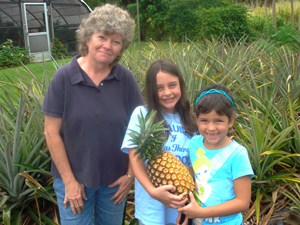
Photo: Donna Mitts with Pa‘auilo School students Nina Corabi and Kaile Dills. The students are holding the biggest pineapple of the season, a whopping 6.75 lbs!
On Saturday, April 24, from 1 to 5 p.m., the Hawai‘i Island School Garden Network (HISGN) will host its first ever “Art, Literature, and Music in the School Garden” workshop at the Hawai‘i Academy of Arts & Science Public Charter School (HAAS) in Pāhoa. This free event is open to students and their families and will feature hands-on activities which celebrate the beauty of our school gardens through art, literature, and music.
By supporting children in school gardens we help teach some very important and fundamental life skills. By exposing children to art, music, and literature in a garden setting we can help children understand the beauty and inspiration found in gardens.
—Donna Mitts, East Hawai‘i Coordinator, Hawai‘i Island School Gardens Network
Read "Inspiring the Genius Within" on the Back Page.

The Beauty of This Garden Is You!
By Patti Cook and Pedro Tama
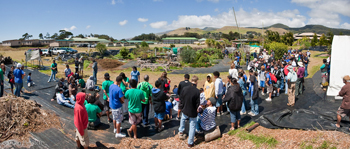
Photo: Mala‘ai: The Culinary Garden of Waimea Middle School (WMS). Photo by Craig Elevitch.
Mala‘ai formally celebrated its 5th anniversary on March 3, 2010, by accepting a prestigious Cooke Foundation Beautification Award for its ¾-acre organic garden, which was once a Parker Ranch pasture. “The real beauty of this garden is each of you,” said WMS Principal John Colson, referring to the large gathering of students and friends of Mala‘ai, as he accepted the Beautification Award from Cooke Foundation board member Thane Pratt.
At the mid-day March event, as cloud-shrouded Mauna Kea stood sentinel against a bright blue sky, the trade winds stormed across its slopes towards Waimea. Nearly 200 young and old gathered in the wind by the garden, equally divided between student-gardeners and community supporters, to hear Kumu Pua Case present the opening pule (prayer). In the very moving introduction that followed, Kumu Case, who is also the ‘Ike Hawai‘i teacher for Waimea Middle School, declared that, “Five years ago we pledged to create out of this land a learning tool and experience that would help make our children healthy and our school community whole—and we did.”
The school garden’s stunning visual transformation—from knee-high kikuyu grass to a beautiful, productive vegetable, fruit, and flower garden—belies a more subtle but significant shift both in school and community awareness of the value of hands-on experiential learning. Not only did Waimea Middle School students grow and harvest more than 6,000 pounds of fresh produce in the Mala‘ai school garden in 2009 to taste and share with their families, school faculty, and friends, but in the process, they learned about healthier food choices, the cycles of nature, the stories and cultural practices of past generations and civilizations, and how to work together and problem solve. They learned about food self-reliance, safety, and sustainability.
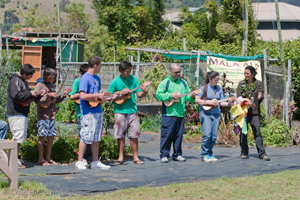
Photo: Student musicians for the 5th Anniversary celebration were (from left to right) Ocean Mercado, Jordan Asia Juan, Patrick Ka‘aihue, Quenten Anastacio, music teacher Mikiala Yardley, and Kamele Sanchez, shown here with Garden Director Amanda Rieux. Photo by Craig Elevitch.
They are not alone. In the past five years, over 50 other Hawai‘i Island schools have started or are planning to start a learning garden and have joined The Kohala Center’s Hawai‘i Island School Garden Network. Even the White House in Washington, D.C., has planted a kitchen garden with the help of public charter school students!
“Every student at our school today and hundreds and hundreds of others have practiced pa‘ahana (hard industrious work) alongside their teachers and volunteers from our community to make our garden the thriving, bountiful, and beautiful place it has become,” said Mala‘ai Garden Director Amanda Rieux when thanking the Cooke Foundation for the award, which included a $5,000 gift to the school to help sustain the classroom garden.

Rare Birds
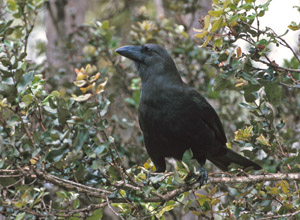
Photo: Alala—found only in the forests on the Kona side of Hawai‘i Island, the last Alala disappeared in the wild in 2002. KBCC has been raising these extremely endangered birds in captivity where the population is now 67. Loss of habitat and predation are the main reasons for its demise in the wild.
On Saturday, May 15, friends of The Kohala Center will journey to the Keauhou Bird Conservation Center (KBCC) in Volcano, where they will see and learn about the rare native Hawaiian birds that this facility houses. KBCC is one of two centers operated by The Zoological Society of San Diego as part of the Hawai‘i Endangered Bird Conservation Program. This program aims to establish self-sustaining populations of birds in the wild using captive propagation and reintroduction management tools.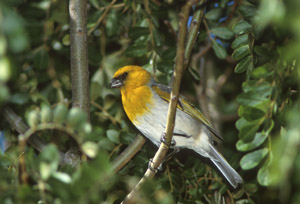
Photo: Palila are known only from the high elevation mamane-naio dryland forests on Mauna Kea volcano on Hawai‘i Island, where the population is less than 2,000 birds. Habitat loss due to feral animal grazing and drought are the main reasons for the wild population decline. KBCC has been captive rearing palila and successfully releasing them into protected high elevation dryland forest on the north side of Mauna Kea in an attempt to establish a new population. Currently there are 26 palila in captivity.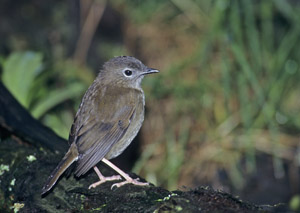
Since this trip is currently fully subscribed, our guide Jack Jeffrey has generously provided us with three photos and brief descriptions of birds that KBCC has in captivity at the moment, for your viewing pleasure.
Photo: Puaiohi—found only deep in the Alaka‘i Swamp on the Kaua‘i Island, the Puaiohi, or small Kaua‘i Thrush, has a wild population of about 200–400 birds. KBCC has been captive rearing this endangered species since 1996 and has successfully released Puaiohi into the wild to bolster existing wild populations. Currently there are 15 Puaiohi in captivity. Disease, predation, and habitat loss are the main reasons for its endangerment in the wild.
To become a friend of The Kohala Center and receive notices about upcoming learning events, visit http://www.kohalacenter.org/member.html.


Subscribe to Kalei Nu‘uhiwa's Hawaiian Moon Newsletter.
Please click here and then send from your e-mail. Mahalo!

